IJCRR - 5(12), June, 2013
Pages: 146-153
Date of Publication: 28-Jun-2013
Print Article
Download XML Download PDF
ESTIMATION OF NOISE FIGURE USING GFF WITH HYBRID QUAD PUMPING
Author: V.R. Prakash, Himanshu Shekhar, Kumara Guru Diderot P.
Category: Technology
Abstract:This Paper describes the models and simulation of EDFA(Erbium Doped Fiber Amplifier) with optimized Gain and that has been flattened using GFF(Gain flattening Filter) with reduced noise figure using Hybrid Quad Pumping with the wavelengths 980nm and 1480nm oppositely cascaded (Co directional pumping and counter directional pumping) architectures a nd compares the results with EDFA with dual pumping techniques. In DWDM networks EDFA'S are an imperative element and are regarded as a cost effective replacement of classical optoelectronic regenerative repeaters EDFA plays an important role in improvement of performance of optical fiber transmission systems. The proposed model consists of Input source, pumping sources with the wavelengths 980nm, 1480nm connected cascade in opposite sides and Isolator. The Erbium doped fibre amplifier's gain which appears in the signal to noise ratio expression is computed from the simulation. The resulting models accurately represent EDFA flattened gain dynamics and reduced noise figure. Simulation results EDFA with Hybrid quad pumping model1 with first stage of the wavelengths 980nm twice times and in the second stage 1480nm twice a times show a flattened maximum gain of 5.4DB and noise figure of 7.6 db and EDFA with Hybrid quad pumping model2 with first stage of the wavelengths 980nm and 1480nm and in the second stage 1480nm and 980nm show a flattened maximum gain of 5.3 DB and noise figure of 8.4db. This is applicable in Network reconfiguration and Multi -vendor networks and also addition new services and wavelengths.
Keywords: EDFA, Quad Pumping, Isolator, WDM, Gain, Optical communications and Optical fiber Amplifiers, Gain flattening filter
Full Text:
INTRODUCTION
Now days, Internet services require large bandwidth, so EDFA’s are used in WDM Technology which increases the optical network capacity without affecting the cost [1]. EDFA finds its applications in optical networks and are used as pre-, line- and power amplifiers giving multi channel amplification with insignificant cross talks. In the ordinary EDFA the optimum Gain efficiency is always accompanied by a compromise in noise figure to a value well above the quantum limit [2]. Hence in our work we are providing EDFA’s with wide and Flat Gain spectrums as well as reducing the Noise figure nearly by half. A wavelength far from the emission peak around 1530nm has to improve the amplification characteristics of the L- band and C-band EDFA. An important issue is the selection of a proper pump wavelength or a suitable pumping configuration. The pump wavelength dependence of the amplification characteristics of the EDFA has been reported mainly in 800-, 980-, and 1480-nm bands and now the 980- and 1480-nm bands, are mostly used for the L- band and C- band EDFA’s. A typical Fixed Gain EDFA contains a length of Erbium Doped Fiber (EDF), followed by a Gain Flattening Filter (GFF). The amplifier is operated such that the EDF provides a fixed amount of Gain, while the GFF is designed to have a spectral attenuation profile that exactly compensates for the spectral gain profile of the EDF. In this way the spectrum at the output of the EDFA is flattened [3]. If the amplifier is operated at another gain, the GFF will not exactly compensate the gain profile of the EDF, and the output of the amplifier will no longer remain flattened. However, for a given length of EDF the gain profile can change drastically as a function of gain, to compensate for such a high gain tilt the GFF would need to attenuate the higher gain wavelengths by a very large amount, thus making the amplifier very inefficient. A relatively high-powered beam of light is mixed with the input signal using a wavelength selective coupler. The input signal and the excitation light must of course be at significantly different wavelengths. The mixed light is guided into a section of fiber with erbium ions included in the core. This high-powered light beam excites the erbium ions to their higher-energy state. When the photons belonging to the signal at a different wavelength from the pump light meet the excited erbium atoms, the erbium atoms give up some of their energy to the signal and return to their lower-energy state. A significant point is that the erbium gives up its energy in the form of additional photons which are exactly in the same phase and direction as the signal being amplified. So the signal is amplified along its direction of travel only. This is not unusual - when an atom “lases” it always gives up its energy in the same direction and phase as the incoming light. That is just the way lasers work. Thus all of the additional signal power is guided in the same fiber mode as the incoming signal. There is usually an isolator placed at the output to prevent reflections returning from the attached fiber. Such reflections disrupt amplifier operation and in the extreme case can cause the amplifier to become a laser. Figure 1. Shows the EDFA with dual pumping using the wavelengths 980-nm in both sides of EDFA as a first model and 1480-nm in both the sides of EDFA as a second model and 980- nm in one side of EDFA and 1480-nm in other side as third model like three models has been computed and simulated and analyzed the performance with the parameters of Gain and Noise figure of Dual Pumping EDFA and also compared with the results of Proposed Hybrid Quad Pumping EDFA models. The block diagram consists of input Source, Isolator, EDFA, WDM, Pumping sources and Isolator allows only forward propagation for that there is no reflected signal. In the Proposed Hybrid Quad pumping technique gives optimized gain has been flattened with reduced noise figure and is compared to Dual Pumping EDFA, the gain has been flattened with the same value of noise figure.
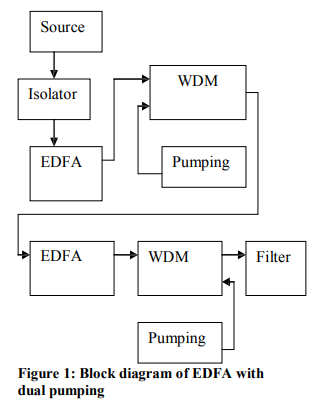
The paper is organized into six sections. In section II Background of this work, while section III presents the methodology and the proposed work Section IV demonstrates the model Simulation details. Section V presents the results and discussions. Finally, the paper is concluded in section VI.
BACKGROUND
In the late 80’s Erbium Doped Fiber Amplifiers (EDFA) have been a target of several improvements. In optical Networks, using EDFA’s it is possible to extend transmission distances and the capacity. The paper [1] proposed a highly reliable approach to EDFA gain and output power control and a power monitoring scheme for fault detection in WDM Networks. These techniques employ a power stabilized control channel, the EDFA gain and output power are controlled by monitoring it. This paper [2] demonstrated and tested a new configuration of EDFA, which enables to efficiently amplify high and low power level signals. The small signal gain is improved by more than 5 dB with the double pass configuration. This paper [3] presents a composite EDFA configuration which incorporates an optical isolator and investigated highly efficient amplifier configurations with high total gain and narrow ASE spectrum. This paper [4] proposed an EDFA pumped in the 660nm and 820nm bands wavelength and increased the signal power and gain. This paper [5] presents amplifier’s gain and power noise which appear in the signal to noise ratio expression, are computed in terms of the internal parameters from simulations and are shown to contribute to its improvement. This paper discusses [6] a new approach for a hybrid gain controlled EDFA based on a complementary actuation of the optical and electronic gain control technique with suppressed transients. The result shows a maximum of 0.6 dB deviation from the set EDFA gain value. This paper [7] without noise figure degradation of L-Band EDFA with 1480 nm discusses power conversion efficiency and improvement without noise figure degradation.
METHODOLOGY
In this work, we proposed the two models of EDFA with Hybrid Quad Pumping using different wavelengths, simulated the models and also compared the results with Dual pumping model and Hybrid quad pumping models using EDFA and WDM blocks and a high performance approach is presented that has not been used in this manner before for such design. Erbium doped fiber amplifiers (EDFA) employed in Wavelength Division Multiplexing (WDM) systems have been shown to incur system impairment due to transient flattened gain with reduced noise.
Applied Methodology
The applied methodology is based on an Opposite Cascade approach. Each block in the architecture was added in t h e model a nd tested a n d l a t e r t h os e b l o c k s w e r e assembled and were added to compose the complete system and then simulated and tabulated the parameter values. Proposed Work Figure 2 shows the General block diagram of Hybrid Quad Pumping. It consists of Input Source, Isolator, Each EDFA of length 10m, WDM (Wavelength division Multiplexer) and Filter. 1 st Proposed model is similar to the General Block diagram except the EDFA using Hybrid Quad Pumping with the wavelengths 980-nm twice a times (in Co directional) and 1480-nm twice a times (in Counter directional). Similar to 1 st model, in the 2 nd Proposed model the EDFA is also using Hybrid Quad Pumping with the wavelengths 980-nm and 1480-nm (in Co directional) and 1480-nm and 980-nm (in Counter directional). A wavelength-division-multiplexing (WDM) technique combined with erbium-doped fiber amplifier (EDFA) is essential for realizing high capacity light wave transmission and flexible optical networks. Compared with Unidirectional transmission, bidirectional transmission over a single fiber has the advantage of reducing not only the number of fiber link, but also the number of passive components such as splitters and WDM multiplexers. Recently, lots of problems in bidirectional EDFAs were investigated, and various structure schemes of the EDFA were reported to overcome the problems, such as back reflections [3] An automatic gain control (AGC) function for bidirectional EDFAs, however, has been rarely reported[4]. This method has the advantage of providing optical fiber with few Erbium clusters because the Er is uniformly doped into silica soot perform in a vapor phase atmosphere. In order to attain highly efficient EDFA’s, the three key factors outlined below must be considered. The first is the Erbium concentration effect on Erbium cluster generation in silica- based glass. It has already been confirmed that an increase in Erbium concentration causes deterioration in amplification efficiency [4]. In the block diagram, we are using an optical source with multiple channels (1520-nm to 1618-nm) whose output is given to the isolator. The isolator allows only the forward propagation restricting the reverse propagation. Further the output of the isolator and the first pumping source (codirectional) has been multiplexed using WDM technique. This multiplexed signal is given to the first EDFA where the signal is amplified to improve the gain characteristics. Again the output is multiplexed with the second pumping source (co-directional), which is then amplified by the second EDFA. The amplified output is given to WDM to combine with third pumping source in counter directional and again given to Third EDFA to increase gain and then given WDM to combine with Last pumping source (Counter directional).
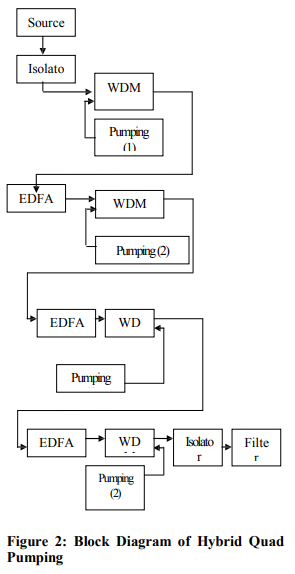
Counter directional pumping gives high gain and Co- directional pumping allows less noise performance especially 980nm pumping gives better noise performance and achieves better population inversion than 1480nm wavelength. The second important factor is to design a fiber structure to maximize the pump/dopant overlap and therefore attain maximum pump efficiency. In previous work, it has been established that Erdoped fibers with a high NA can greatly increase the pumping intensity in a very small core, resulting in a very large gain coefficient. An Er-doped high NA fiber was achieved using a glass system consisting of an ErGe-co- doped silica core and fluorine (F)- doped silica cladding. The fiber has a relative refractive-index difference of 1.88%, which corresponds to a 0.285 numerical aperture.
MODEL SIMULATION
First Hybrid Quad pumping model with the wavelengths 980nm twice times in codirectional 1480-nm twice times in Counter directional has been simulated as shown in Figure 3. And the second Hybrid Quad pumping model with the wavelengths 980-nm, 1480-nm in the co-directional and 1480-nm, 980-nm in the counter directional has been simulated as shown in Figure 8. The parameters Gain and Noise figure has been measured from the simulation models before and after Gain Flattening Filter and that has been plotted as shown in Figure 4, Figure 5 Figure 6 and Figure 7.
Figure 9 and Figure 10 shows Gain characteristics and noise characteristics before GFF of 2nd simulation model. Figure 11 and Figure 12 show the Gain characteristics and Noise Figure Characteristics after GFF of 2nd Simulation model.
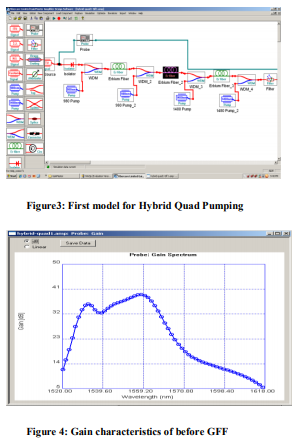
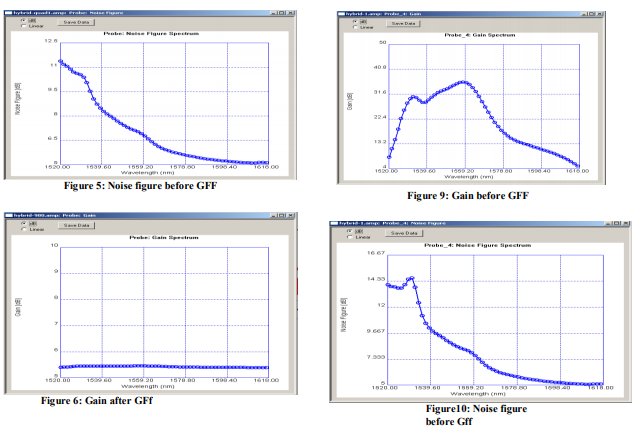
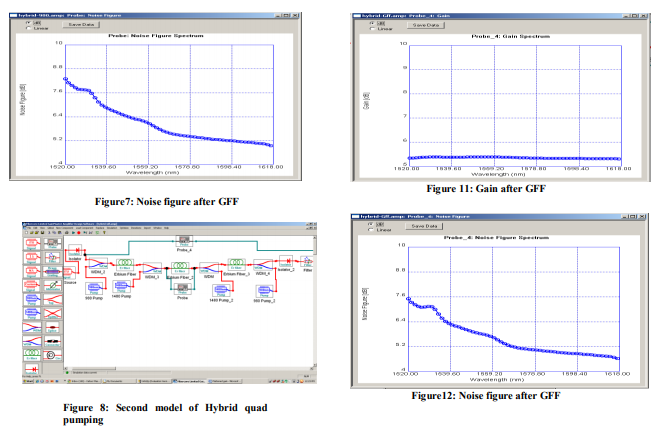
RESULTS AND DISCUSSIONS
The Plotted Values of simulation results before re and after GFF are tabulated as shown in Table I. Table I shows the simulation results of 1st and 2nd Hybrid Quad pumping models (Proposed) were compared with Dual Pumping techniques with different wavelengths. The results of Dual pumping models are, Gain has been flattened after GFF but Noise Figure has been maintained. For the Hybrid Quad pumping models, after GFF Gain has been flattened but Noise Figure has been decreased half, means output noise has been decreased half. Table I. shows the tabular representation of the simulation results and comparison of Gain with and without GFF (gain flattening filter) with 980nm, 1480nm, dual and quad hybrid directional pumping. In the first proposed model with hybrid quad pumping (980nm twice in left of EDFA and 1480nm twice in right of EDFA) the gain without GFF is 38.7 and gain with GFF is 5.3 flattened. In the second proposed model with hybrid quad pumping (980nm, 1480nm in left of EDFA and 980nm, 1480nm in right of EDFA) the gain without GFF is 35.9 and the gain with GFF is 5.3 flattened.
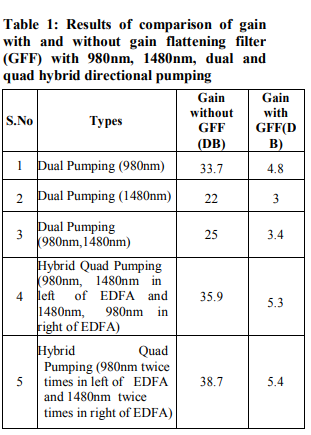
Table 2 show results of comparison of Noise Figure with and without Gain Flattening Filter (GFF) with 980nm, 1480nm, Dual and Quad Hybrid Directional Pumping. In the first proposed model with hybrid quad pumping (980nm twice in left of EDFA and 1480nm twice in right of EDFA) the noise figure without GFF is 11.5 and noise figure with GFF is 8.4 flattened. In the second proposed model with hybrid quad pumping (980nm, 1480nm in left of EDFA and 980nm ,1480nm in right of EDFA) the noise figure without GFF is 14.8 and the noise with GFF is 7.6 flattened.
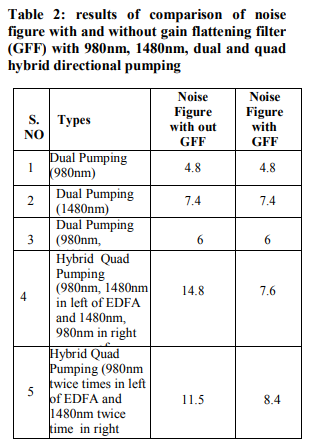
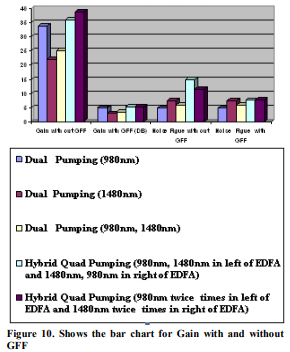
Figure 10. Shows the results of bar chart, comparison of Gain with and without GFF for different pumping models.
CONCLUSION AND FUTURE ASPECTS
The capability of Simulating Models of EDFA with Hybrid Quad pumping with and without GFF is proposed in this work. Based on above discussion it can be concluded that an EDFA with Hybrid Quad pumping has been modeled and simulated successfully with flattened gain and reduced noise figure for DWDM networks to increase transmission quality. Goal is to model Hybrid Quad pumping that would model some real world phenomena using EDFA. Thus, we have shown that the proposed model of an EDFA with Hybrid Quad Pumping was successfully simulated using WDM. In future work, the model can be modified and enhanced further by using different filters will concentrate further optimize the gain
References:
1. N. Zervas, R.L. Laming and David N. Payne," Efficient EDFA incorporating an optical isolator”, In IEEE journal of quantum electrinics, March 1995, vol 31, no.3 UK .
2. Aditya Goel and Ravi Shankar Mishra, “Design of broadband EDFA for next generation optical network”, International journal of Neural networks and applications, jan-june 2010, pp.9-13.
3. J.H. Jang, J.H. Jung, K.K.Lee, “Implementation of Automatic gain controlled bidirectional EDFA in WDM Networks” , IEEE CLEO/Pacific Rain 1999.
4. Masaharu horiguchi, IEEE Journal of Lightwave technology, Vol 12, no.5, May 1994.
5. Temmer, H. Ould Saadi and A. Boutaleb, “Simulation based analysis of EDFA, Journal of Applied science, Asian network for scientific information,page no. 789- 794, 2006.
6. M.Karasek, “Gain enhancement in gain shifted EDFA for WDM applications”, IEEE photonics technology letters vol 11 no. 9, September 1999.
7. S.W. Harun, N.N. Samsuri, H.Ahmad, “Partial gain clamping in two stage double pass L band EDFA using a ring resonator”, IEEE 2004.
|






 This work is licensed under a Creative Commons Attribution-NonCommercial 4.0 International License
This work is licensed under a Creative Commons Attribution-NonCommercial 4.0 International License